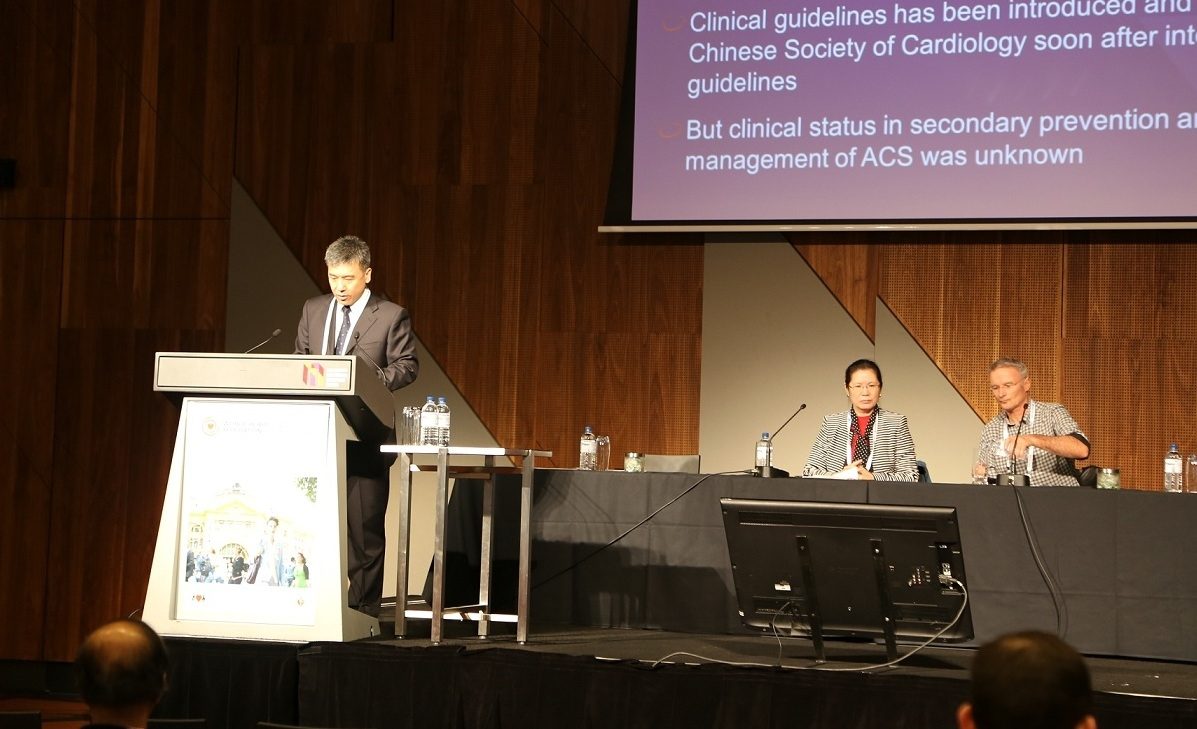
Professor Yangfeng WU speaking on China CVD Prevention Policy Priorities at 2014 World Congress of Cardiology
The 2014 World Congress of Cardiology (2014WCC) was held in Melbourne on May 4 -7, 2014. Professor Yangfeng WU from The George Institute for Global Health at Peking University Health Science Center gave speech on Reducing Premature Cardiovascular Disease Moartality in China at the WHF-WHO Joint Session.
The World Congress of Cardiology Scientific Sessions (WCC 2014) was held in Melbourne, Australia on May 4-7, 2014, providing a platform for cardiovascular disease experts and academics from around the world to explore possible solutions to major global health issues and cardiovascular disease in developing countries and regions.
In 2011, UN High Level Meeting on the Prevention and Control of Non Communicable Diseases (NCDs) has made a political declaration underlining that burden of NCD has become the major global health issue and the obstacle to economic development. The Global Action Plan for the Prevention and Control of NCDs proposed by the WHO attained nine global targets, including the “25×25 roadmap”, a 25% relative reduction in premature mortality from NCDs by 2025.
The “25×25 roadmap” is also one of the main topics of the WCC 2014. The World Heart Federation (WHF) set the goal of reducing premature mortality by non-communicable diseases, including cardiovascular diseases, by 25% by 2025. It stressed the pillars of heart-healthy environments, calling for preventing and controlling CVDs in an economic and sustainable way by taking global actions.
Professor Yangfeng WU said, “NCD is not only a health issue. It is more like a social issue, restricting economic development. NCD has become a major issue for China. It must be effectively addressed, so that the people in China can live a much healthier and happier life. Tackling NCDs effectively is an important element of the Chinese Dream.
Professor Yangfeng WU has made his presentation titled “Reducing Premature CVD Mortality in China: Policy Priorities” in the session “Tackling CVD in the 21st Century: the Role of Public Health Policy” jointly hosted by WHF and WHO. He introduced the challenges and difficulties in China of cardiovascular disease prevention and control, pointing out its future opportunities and policy priorities.
NCD in China—big burden, small capacity, huge challenges
NCD mortality rate has been running at a high level in China, and has continued to increase, resulting in growing huge disease burden. China has a large and aging population. Compared to the developed countries, the air pollution in China is serious. As industry and economy rapidly develops, people live more and more unhealthy. Yet their awareness of disease is still low. These have become a huge challenge to NCD prevention and control. Yet the health care system in China is still focusing on addressing acute infectious diseases, not being able to cope with the increasingly large NCD burden.
Taking whole-of-government and whole-of-society approaches should be the first choice of NCD prevention and control in China
UN and WHO stressed that effective NCD prevention and control requires leadership, coordinated multi-stakeholder engagement for health both at government level and at the level of a wide range of actors, with such engagement and action including, as appropriate, health-in-all policies and whole-of-government approaches across sectors. The Chinese government actively responded the UN initiative, introducing China's first NCD prevention and control action plan in 2012, with 15 ministries collaborating to combat NCDs.
To implement the plan, the Chinese government is planning to establish national NCD prevention and control demonstration areas, propose a universal healthy lifestyle initiative, and promote the national fitness program. Other policy options include reforming the current healthcare system and strengthening primary care and public health system. Fortunately, these have been included as the essential elements of China’s new healthcare system reform. Basic public health services program implemented in 2009 includes a standardized management of hypertension and diabetes.
Up to 2011, the number of patients included in the hypertension management in China has reached 42 million. The other two options proposed by WHO are also important for NCD prevention and control in China, which are tobacco control and salt reduction. To strengthen scientific research capacity can provide evidence for NCD prevention and control. Though the NCD prevention and control in China is facing great challenges, appropriate policy decision, collaboration, and innovation can help achieve the goals of NCD prevention and control, contributing to achieve the NCD prevention and control goals globally.


